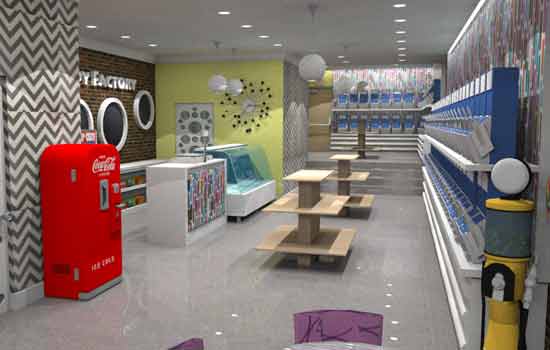Students share ideas to revitalize Honeoye Falls
Interior design students will showcase inspirations at a May 16-26 show
A candy factory designed by NTID student Angela Read is one of the ideas by RIT interior design students to revitalize the village of Honeoye Falls that will be part of a May 16-26 show.
How can a group of Rochester Institute of Technology interior design students help to revitalize Honeoye Falls and bring back businesses to the village? What combination of design thinking, evidence-based design and business savvy could these students bring that would revitalize Main Street again?
Those questions were posed during an independent studies project at the College of Imaging Arts and Sciences this semester, and the students’ resulting visions will be highlighted during an opening reception from 5:30 p.m. to 8:30 p.m. Friday, May 16, at 5 W. Main St. Honeoye Falls. The show continues through May 26.
Titled “RIT Envision: Honeoye Falls,” the project was led by Christina Birkentall, a visiting assistant professor of interior design, whose students have been working directly with the chamber in Honeoye Falls/Mendon to create concept designs for potential businesses to fill the empty storefronts while at the same time maintaining the village’s historical charm.
Part of the town of Mendon, Honeoye Falls—a village of approximately 2,600 people located about 12 miles southeast of RIT—is attempting to recover from the loss of a number of area businesses, particularly the closure of a General Motors fuel cell plant 18 months ago that employed hundreds of people who frequented Main Street businesses regularly.
The “Envision” project was recently showcased as an exhibit at the annual Imagine RIT: Innovation and Creativity Festival, which drew more than 32,000 visitors to campus May 3. The hands-on display inside Gordon Field House featured a giant model of the village on which visitors could create their own businesses or “plant” trees using pre-made cardboard buildings and other decorating supplies in the midst of learning about the proposed student-designed businesses.
According to Birkentall, Imagine RIT offered a glimpse of what students will showcase during this Friday’s opening reception.
“Our interior design students provided a wonderful example of this interactive project at Imagine,” said Birkentall, herself a registered interior designer. “The children who visited the exhibit during the festival had such a fun opportunity to help ‘envision’ what a vibrant Main Street business could look like.”
She noted that RIT students this semester have been helping real village businesses to visualize new retail and entertainment venues.
“The students are coming up with a lot of very innovative ideas,” she said. “At the same time, they are getting exposure to real clients and real building spaces, all in the name of helping a community realize the potential business opportunities there.”
One of those students is Cristina Morganti Buttrill, a fourth-year interior design student, who serves as vice president of RIT’s Interior Design Club and International Interior Design Association chapter.
“I think people are surprised when they find out that interior design is not just about paint colors and fabrics—we are not decorators,” said Morganti, of Spencerport, N.Y. “Sure we are responsible for things like furniture and fabrics, but our designs must also meet ADA (Americans with Disabilities Act) guidelines as well as building and life-safety codes. Our first priority is to protect public health, safety and welfare.”
Mallory Monick, a third-year interior design student from Floral Park, N.Y., added that today’s designers need to have sustainability in mind at all times when approaching any project.
“Sustainability has many facets such as appropriate site selection,” Monick said. “Choosing a site that is near other unique businesses can enrich the community, support local businesses and encourage public transportation, which in turn reduces our carbon footprint since people drive less to get to where they want to go.”
Fittingly, the RIT student-designed projects will have a strong focus on Leadership in Energy and Environmental Design (LEED), a set of rating systems established by the U.S. Green Building Council for the design, construction, operation and maintenance of “green” buildings, homes and neighborhoods. Birkentall, in fact, is a LEED Green Associate—a USGBC designation documenting that she has an up-to-date understanding of the most current green building principles and practices.
“LEED helps encourage a walk-able and bike-able local merchant base with a sense of community connectivity—all of which will help businesses thrive and connect people,” observed Birkentall.
All in the name of good design, Morganti added.
“When done well, the design of interior walls, finishes, windows, furniture, fixtures and signage will have a positive effect on everyone,” she said. “It’s about creating beautiful spaces that people will not only want to be in and keep coming back to, but also designing a comfortable and safe environment.”













